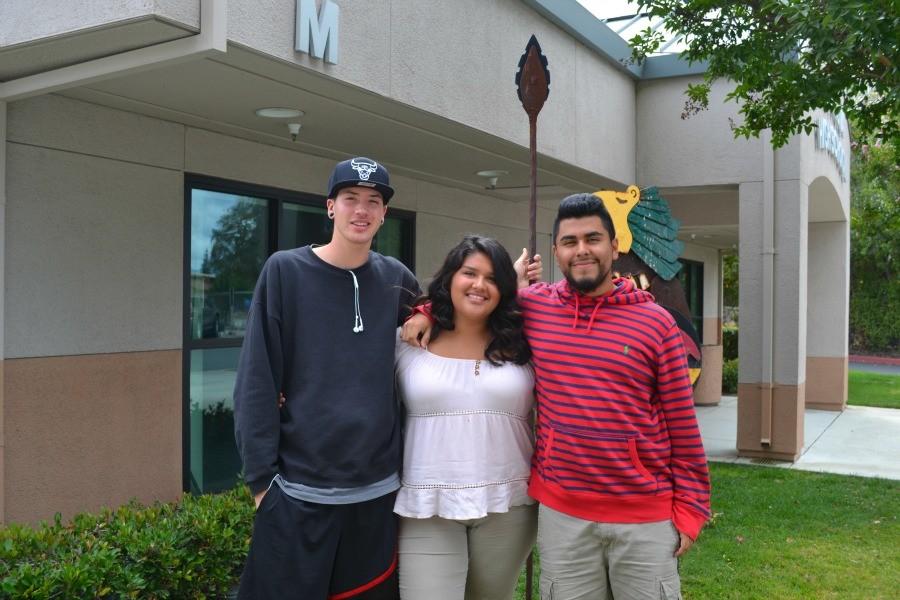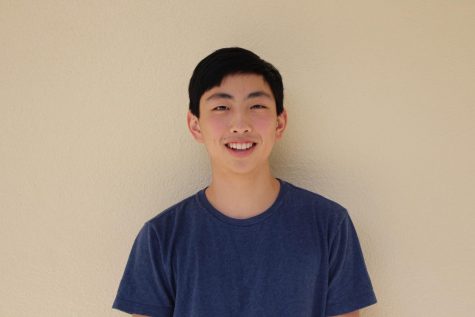Alta Vista: a nurturing community
Alta Vista High School students (left to right) Alejandro Benavidez, Zitlaly Ramirez and Juan Carbajal smile for a group photo. Photo by Gina Kermode.
Alta Vista High School, like many continuation schools, is often stigmatized as a place for struggling students. Yet the secluded mini-campus behind the district office has grown to nurture a small and eclectic population of 146 students. The school’s highly personalized culture has allowed students to feel comfortable and thrive in a tightly knit community.
“A lot of what we hear from the traditional students who request to come over is that there’s a sense of competition, of high levels of stress amongst students,” AVHS Principal Bill Pierce said. “There isn’t that kind of sense here, it’s a much more mellow setting. [It’s] really peaceful, really quiet, we don’t have a lot of discipline issues, which is a big thing people always think about continuation school.”
Set up as alternatives to the traditional high schools, continuation schools were created to provide another route for students who are at risk of not graduating. Many of these students must balance full-time work schedules with school, while others may not have the resources they need to succeed at a traditional, more rigidly structured school. Generally, continuation schools help students by speeding up the credit accretion process and allowing for more flexible schedules.
While credit deficiency and attendance issues are the most common reasons for students to transition to AVHS, the school has also been accruing a larger number of self-referrals, where students choose to transition from Mountain View or Los Altos High School into AVHS.
“We have a growing number of students who are self-referrals, who say, ‘You know what, traditional schools are just not a good fit for me,’” Pierce said. “They need a smaller setting, a more personalized educational experience.”
The growing popularity can be attributed to the very welcoming environment that has allowed students to find a sense of comfort and belonging. The student body is accommodating, and the types of cliques found in many high schools are much rarer.
“I feel like being at this school we all relate more than at Los Altos or Mountain View,” senior Juan Carbajal said. “Over there you’re separated, it’s always different people with different groups. But over here, you can always find someone to talk to. You can always have something in common. It’s also more diverse and accepting.”
With a small staff of seven full-time teachers and two part-time teachers, the faculty has also been key to the nurturing atmosphere. The staff provide a very personalized experience with smaller classes and one-on-one interactions that allow students to experience material in an enjoyable way.
“Teachers know how to challenge students because they know the ones that need extra help and the ones that want a challenge and want to get pushed,” senior Alejandro Benavidez said. “I think that’s something that teachers do here very well. It’s more familiar, each teacher just gets to know you a lot better: how you work, what kind of person you are and what kind of student you are.”
Alejandro had transferred to Alta Vista for sophomore year, after his counselor deemed him credit deficient. The transfer, however, has allowed Alejandro revitalize his education by making classwork and enjoyable experience.
“Just the acknowledgement that there are actually good teachers out there, it really does add to like you want to learn more, makes you want to enjoy the class more,” Alejandro said. “And they work with you one on one. They’re paying more attention to you, and it makes you feel like you matter. It makes you care more about your education.”
For some students, the school has changed the way they approach education. With a much larger array of opportunities, they feel more motivated to take action for themselves.
“At first I thought, ‘I’m a procrastinator, I don’t do school,’” senior Zitlaly Ramirez said. “Once I got here, I’ve been exposed to so many opportunities that I’ve learned that I like school. I’ve learned to love math, whereas before it was just something I’ve had to do. Here, I think people have discovered what works best for them.”
Ever since moving to a full six-period schedule three years ago, Alta Vista has offered a large variety of electives and differing educational pathways for students to choose from. One of the long-standing pathways is Construction Trades, which deals with an array of different construction skills. This year, the construction class built chicken coops, an unexpected eccentricity that has begun to involve the whole school in the process of raising chickens.
“I think the chickens are good, because it kind of involves everyone,” Juan said. “It’s really interesting to have chicken on campus, and I’ve never seen it before. It brings people together.”
In fact, the school has become an exhibition for Silicon Valley’s annual Tour de Coop, a bike tour that visits different Silicon Valley homesteads to see chicken coops, gardens and beehives. Sponsored and organized by Slow Food South Bay, a company that promotes local food communities, and other collaborating organizations, the free self-guided tour allows the Construction class an opportunity to sell their coops.
“There are some 900 people signed up to do a chicken coop tour, so we’re going to have an open house on [Saturday, September 19],” Pierce said. “[For] this particular tour, we’ll be able to say, ‘Hey, if you like our chicken coop, we’ll build one for you.’”
Along with Construction Trades, Alta Vista has health science and early childhood development paths that offer certifications and college credits. The elective paths allow students to find their own way through high school and chase their own passions.
“Since I was younger, I always thought that I wanted to be a vet,” Zitlaly said. “When I was at Los Altos I didn’t think I would be able to reach that. I got here and the old science teacher, he was on the alumni board for Cal Poly, which offers veterinary technician courses. He said, ‘If you get the grades for it when you go to college, I will write a recommendation letter that will get you into that school.’ I thought, ‘Maybe I can be a vet.’”
Through these processes, Alta Vista prepares students for community college, where most graduates will go before transitioning to a university of their choice.
“On the wall, we have college banners from a variety of the universities our students have gone to,” Pierce said. “It’s important that we have those images up because a number of students when they first come, think, ‘Well this is sort of a dead end, I’ll get my diploma and that’s it,’ which is far from the case. This is simply a different path to the same end… graduation of college.”
Alta Vista constantly battles the “continuation” school stigma that shadows its identity. Parents of AVHS students, at first, are especially fearful for their kids ― that is, until they visit the school.
“Parents are worried about their kids coming to the ‘continuation’ school,’” Pierce said, “Once they come on campus, ‘Ah, this is like a little private school.’ ‘Yeah it is,’ I say, ‘I promise you when your student goes home today, they’re going to say, “I like school.”’”
In the end, these negative associations are purely figments of the imagination. Dispelling the prejudices, however, is an uphill battle.
“I don’t think anybody really knows,” Juan said. “I assumed it was a bad school, I was informed it was a bad school. I thought there were gangs there, and you’re going to get shot or stabbed the first day you come on campus. But then once you come, you realize that it’s not bad. You find your group, you find your friends. After a couple of weeks, I really liked it here.”




